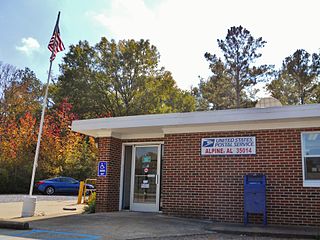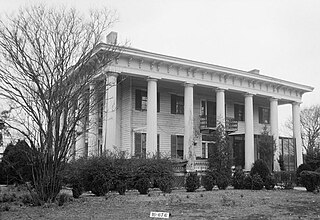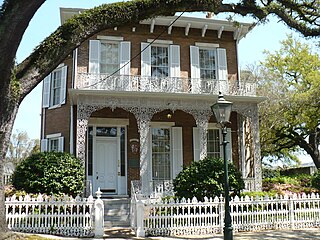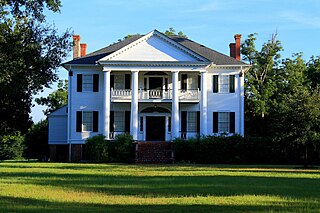A plantation house is the main house of a plantation, often a substantial farmhouse, which often serves as a symbol for the plantation as a whole. Plantation houses in the Southern United States and in other areas are known as quite grand and expensive architectural works today, though most were more utilitarian, working farmhouses.

Bride's Hill, known also as Sunnybrook, is a historic plantation house near Wheeler, Alabama. It is significant as an example of a Tidewater-type cottage. It was added to the Alabama Register of Landmarks and Heritage on April 16, 1985, and to the National Register of Historic Places on July 9, 1986.

Rosemount is a historic plantation house near Forkland, Alabama. The Greek Revival style house was built in stages between 1832 and the 1850s by the Glover family. The house has been called the "Grand Mansion of Alabama." The property was added to the National Register of Historic Places on May 27, 1971. The Glover family enslaved over 300 people from 1830 until 1860.

The Goode–Hall House, also commonly known as Saunders Hall, is a historic plantation house in the Tennessee River Valley near Town Creek, Alabama. It was added to the National Register of Historic Places on October 1, 1974, due to its architectural significance.

Magnolia Grove is a historic Greek Revival mansion in Greensboro, Alabama. The house was named for the 15-acre (6.1 ha) grove of Southern magnolias in which it stands. It was added to the National Register of Historic Places on April 11, 1973, due to its architectural and historical significance. It now serves as a historic house museum and is operated by the Alabama Historical Commission.

Fairhope Plantation is a historic Carpenter Gothic plantation house and historic district, located one mile east of Uniontown, Alabama, US. The 2+1⁄2-story wood-framed main house was built in the Gothic Revival style in the late 1850s. The plantation historic district includes six other contributing buildings, in addition to the main house. It was added to the Alabama Register of Landmarks and Heritage on December 19, 1991, and subsequently to the National Register of Historic Places on May 29, 1992, due to its architectural and historical significance.

Alpine is an unincorporated community in Talladega County, Alabama, United States, located southwest of Talladega and northwest of Childersburg. It is known to Alabama residents as the site of YMCA Camp Cosby. The community gained its name from Alpine, a plantation owned by the Welch family. Over time, a town grew up around the plantation when a railroad came through. Initially known as Welchs Depot, it eventually came to be known as Alpine, in honor of the plantation.

The Protestant Children's Home, also known as the Protestant Orphans' Asylum, is a historic orphanage building in Mobile, Alabama, United States. It was placed on the National Register of Historic Places on June 18, 1973.
In 2015 the building was leased to the Infant Mystics society which began using it as a meeting lodge, renaming the place Cotton Hall.

Sturdivant Hall, also known as the Watts-Parkman-Gillman Home, is a historic Greek Revival mansion and house museum in Selma, Alabama, United States. Completed in 1856, it was designed by Thomas Helm Lee for Colonel Edward T. Watts. It was added to the National Register of Historic Places on January 18, 1973, due to its architectural significance. Edward Vason Jones, known for his architectural work on the interiors at the White House during the 1960s and 70s, called it one of the finest Greek Revival antebellum mansions in the Southeast.

Belle Mont is a historic Jeffersonian-style plantation house near Tuscumbia in Colbert County, Alabama. It was added to the National Register of Historic Places on February 23, 1982, due to its architectural significance.

Rocky Hill Castle, also known simply as Rocky Hill, was a historic plantation and plantation house between Town Creek and Courtland, Alabama, United States. Once famed in Alabama for its architecture, it was an unusual mixing of neoclassical and picturesque aesthetics in one plantation complex. The house and tower suffered from neglect during much of the 20th century and were subsequently demolished in the 1960s. Much folklore surrounds the site, with Rocky Hill Castle being the subject of numerous ghost stories. The most notable story, "The Ghost of the Angry Architect", was published in Kathryn Tucker Windham and Margaret Gillis Figh's 1969 work 13 Alabama Ghosts and Jeffrey.

Spring Villa is a historic Carpenter Gothic plantation house on the outskirts of Opelika, Alabama. Inspired by designs published by Andrew Jackson Downing, the house is one of only about twenty remaining residential examples of Gothic Revival architecture remaining in the state. It was built by William Penn Yonge in 1850 next to a 30-acre (12 ha) spring-fed lake, from which it takes its name.

Mount Ida, also known as the Walker Reynolds House, was an antebellum mansion, built in the Greek Revival style beginning in 1840 by Walker Reynolds, between Sylacauga and Talladega in rural Talladega County, Alabama, United States.

Dicksonia, also known as the Turner-Dickson House, was a historic plantation house just south of Lowndesboro, Alabama, United States. Dating back to 1830, it was destroyed by fire twice. The house was recorded by the Historic American Buildings Survey in 1934 and the ruins were later featured in the 1993 book Silent in the Land. For the May 1999 issue of Vanity Fair magazine, Annie Leibovitz did a photo shoot of Natalie Portman at the ruins on February 7, 1999.

The Dr. John R. Drish House, also known simply as the Drish House, is a historic plantation house in Tuscaloosa, Alabama, United States. It is considered by state preservationists to be one of the most distinctive mixes of the Greek Revival and Italianate styles in Alabama. First recorded by the Historic American Buildings Survey in 1934, it was added to the Alabama Register of Landmarks and Heritage on July 31, 1975, and subsequently to the state's "Places in Peril" listing in 2006. It was listed as Jemison School-Drish House on the National Register of Historic Places in 2015.

Aduston Hall is a historic antebellum plantation house in the riverside town of Gainesville, Alabama. Although the raised cottage displays the strict symmetry and precise detailing of the Greek Revival style, it is very unusual in its massing. The house is low and spread out over one-story with a fluid floor-plan more reminiscent of a 20th-century California ranch house than the typically boxy neoclassical houses of its own era.

Belle Mina, known as Belmina during the 19th century, is a historic forced-labor farm and plantation house in Belle Mina, Alabama, United States. Completed in 1826, the Late Georgian-style house was built for Alabama's second governor, Thomas Bibb.

The Richards DAR House is a historic house museum in Mobile, Alabama, United States. The Italianate style house was completed in 1860 for Charles and Caroline Richards. It is a contributing property to the De Tonti Square Historic District, which was listed on the National Register of Historic Places on February 7, 1972. The four Daughters of the American Revolution (DAR) chapters in Mobile jointly operate and maintain the house. It is noted by architectural historians as one of Mobile's best preserved and elaborate examples of mid-19th century domestic architecture.

Lakewood is a historic antebellum mansion in Livingston, Alabama, United States. The two-and-a-half-story Greek Revival-style house was completed in 1840. The house was recorded by the Historic American Buildings Survey in 1936. It was added to Alabama's Places in Peril in 2012, a listing that highlights significantly endangered properties in the state.

Youpon Plantation, originally known as Mimosa and also known as the Mathews-Tait-Rutherford House, is a historic antebellum plantation house and complex near Canton Bend, Alabama, United States. The three-story Greek Revival-style plantation house was completed in 1848. It was extensively recorded by the Historic American Buildings Survey in 1936 and 1937. It was named for the Yaupon holly trees that were once a prominent feature of the front grounds. Architectural historians at the Alabama Historical Commission consider it to be among the most notable of the "stately pillared houses" in Alabama.




















